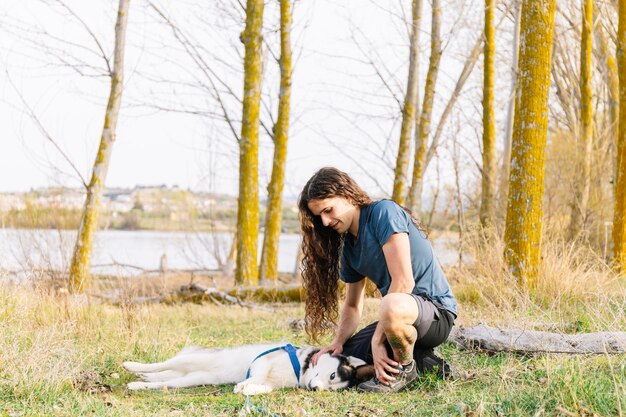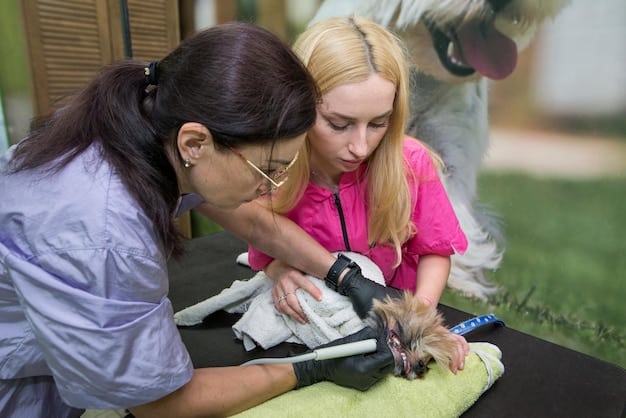Pet First Aid: Essential Skills Every Owner Should Know

Anúncios
Pet first aid encompasses the immediate care given to an injured or ill pet, involving skills and knowledge to stabilize the animal until professional veterinary care is available, ensuring their well-being and increasing chances of recovery.
Being a pet owner comes with immense joy and responsibility, including knowing how to handle emergencies. Understanding pet first aid: essential skills every owner should know can make all the difference in a critical situation, potentially saving your beloved companion’s life.
Anúncios
Why Pet First Aid Matters
Accidents and sudden illnesses can happen anytime. Knowing the basics of pet first aid allows you to provide immediate assistance and comfort, minimizing pain and preventing further complications before reaching a vet.
Pet first aid isn’t about replacing professional veterinary care; it’s about bridging the gap until you can get your pet to a qualified veterinarian. It equips you with the knowledge and skills to handle common pet emergencies confidently.
Anúncios

Common Pet Emergencies
Understanding the types of emergencies your pet might face can help you be better prepared. Here are some common scenarios:
- Wounds and Bleeding: Cuts, lacerations, and punctures can occur from various accidents.
- Choking: Pets can accidentally swallow foreign objects, leading to airway obstruction.
- Poisoning: Ingestion of toxic substances found at home or outdoors poses a significant risk.
- Heatstroke: Overheating is a serious threat, especially during warm weather.
Equipping yourself with the skills needed to address these scenarios will ensure you are ready to assist your pet when accidents occur.
In summary, pet first aid is crucial because it provides immediate assistance, bridges the gap before veterinary care, and prepares you for common pet emergencies. Educating yourself on pet first aid practices serves to greatly benefit your pet’s well-being.
Assembling Your Pet First Aid Kit
Having a well-stocked pet first aid kit readily available is essential. This kit should be stored in an accessible location, and everyone in the household should know its whereabouts.
Consider your pet’s specific needs and any pre-existing health conditions when assembling your kit. Regularly check and replenish the kit to ensure all items are in good condition and within their expiration dates.
Essential Items for Your Kit
- Gauze Pads and Bandages: For wound care and immobilizing injuries.
- Antiseptic Wipes or Solution: To clean wounds and prevent infection.
- Adhesive Tape: To secure bandages and dressings.
- Blunt-Tipped Scissors: For cutting bandages and removing fur around wounds.
Besides these standards, you can also keep a pet carrier in your kit for easy transport as well as a muzzle to avoid bites.
In short, putting together a great pet first aid kit ahead of time is imperative to assisting your pet. It is beneficial to cater the kit to your pet’s specific needs, as well, to ensure you are extra prepared.
Recognizing Signs of Illness and Injury
Being able to recognize when your pet is sick or injured is critical for providing timely care. Familiarize yourself with your pet’s normal behavior and habits so you can quickly identify any deviations.
Subtle changes in appetite, energy levels, or behavior can be early indicators of a problem. Pay close attention to these signs and don’t dismiss them as insignificant.
Key Symptoms to Watch For
Keep checking your pet for the following warning signs:
- Lethargy: Unexplained tiredness or weakness.
- Loss of Appetite: Refusal to eat or decreased food intake.
- Vomiting or Diarrhea: Digestive upset that persists for more than a day.
- Coughing or Difficulty Breathing: Respiratory distress requiring immediate attention.
Recognizing signs of illness and injury is crucial for timely intervention. These symptoms can include decreased water intake, as well, so keep your eye out.
To summarize, recognizing the warning signs of pet illness and injury will help you care for your animal in a timely manner. You can monitor these warning signs early on if you maintain a close watch over your pet’s habits and behavior.
Mastering Essential First Aid Skills
Several essential first aid skills can significantly improve your pet’s chances of recovery in an emergency.
Learning how to control bleeding, administer CPR, and handle choking are invaluable skills that can potentially save your pet’s life.

Controlling Bleeding
Apply direct pressure to the wound using a clean cloth or gauze pad. Maintain pressure until the bleeding stops or slows significantly. If possible, elevate the injured area to further reduce blood flow. If bleeding persists, seek immediate veterinary attention.
CPR (Cardiopulmonary Resuscitation)
Check for a pulse and breathing. If absent, initiate chest compressions at a rate of 100-120 compressions per minute. Alternate with rescue breaths, providing one breath every 5-6 compressions. Continue CPR until veterinary help arrives.
Handling Choking
If your pet is conscious, attempt to dislodge the object by performing the Heimlich maneuver. If your pet is unconscious, open their mouth and try to remove the obstruction manually. If unsuccessful, administer back blows between the shoulder blades.
Mastering essential first aid skills such as these can significantly impact your pet’s chances of survival during an emergency incident. It is important to act fast, as pet injuries carry a limited window of opportunity to treat. You will be glad to act fast when prepared.
Dealing with Specific Emergencies
Each type of emergency requires a specific approach. Some injuries require fast action, while others need a slow, more controlled approach.
Heatstroke, poisoning, and traumatic injuries all require different first aid measures and precautions. Tailor your response to the specific situation.
Heatstroke
Move your pet to a cool environment and offer water. Apply cool, wet towels to their body, focusing on the groin and paw areas. Monitor their temperature closely and seek immediate veterinary care.
Poisoning
If you suspect your pet has ingested poison, contact your veterinarian or a pet poison helpline immediately. Do not induce vomiting unless instructed to do so by a professional. Bring the suspected poison container with you to the vet.
Traumatic Injuries
Handle your pet with extreme care, as they may be in severe pain. Stabilize any fractures or dislocations using makeshift splints. Transport your pet to the nearest veterinary emergency clinic as quickly as possible.
Dealing with these specific emergencies in a timely and appropriate manner greatly benefits your pet’s health. Be sure to remember, also, that each pet injury requires a different first-response approach.
Preventing Pet Emergencies
Prevention is always better than cure. Taking proactive measures to minimize risks in your pet’s environment can help prevent many common emergencies.
Secure toxic substances, supervise outdoor activities, and regularly check your pet for any signs of illness or injury.
Creating a Safe Environment
Remove potential hazards from your pet’s reach. Store medications, cleaning supplies, and pesticides in secure cabinets. Be mindful of poisonous plants both indoors and outdoors. Ensure your yard is free from sharp objects and debris.
Supervising Outdoor Activities
Keep your pet on a leash during walks to prevent them from running into traffic or encountering aggressive animals. Avoid walking during the hottest part of the day to prevent heatstroke. Check your pet for ticks and other parasites after outdoor excursions.
Preventing emergencies requires a pet owner’s consistent efforts in creating a secure environment and supervising outdoor activities. Small changes create lasting positive outcomes, so stick to it.
| Key Point | Brief Description |
|---|---|
| 🩹 Wound Care | Clean wounds with antiseptic and apply proper bandaging. |
| 🌡️ Heatstroke | Cool the pet with wet towels and seek vet assistance immediately. |
| ☠️ Poisoning | Contact vet immediately; do not induce vomiting without instruction. |
| ❤️ CPR | Perform chest compressions and rescue breaths if pet isn’t breathing. |
Frequently Asked Questions
▼
Stay calm and assess the situation quickly. Ensure your safety and the safety of your pet. Then, provide immediate first aid and contact your veterinarian or a local animal hospital.
▼
Signs include difficulty breathing, gagging, pawing at the mouth, or a blue tinge to the gums. Immediate action is needed to remove the obstruction and prevent suffocation.
▼
No, human medications can be toxic to pets. Always consult your veterinarian before administering any medication to your pet to ensure it is safe and properly dosed.
▼
Use a carrier or crate if possible. For larger pets, use a makeshift stretcher or blanket, supporting their body to avoid further injury. Drive carefully to the veterinary clinic.
▼
Check with local veterinary clinics, animal shelters, and community centers. Organizations like the American Red Cross also offer pet first aid courses both online and in person.
Conclusion
Being prepared to handle pet emergencies can significantly improve your pet’s chances of a positive outcome. By mastering essential first aid skills and keeping a well-stocked kit, you can provide immediate care and comfort until professional veterinary help is available, ensuring your furry friend remains happy and healthy.






